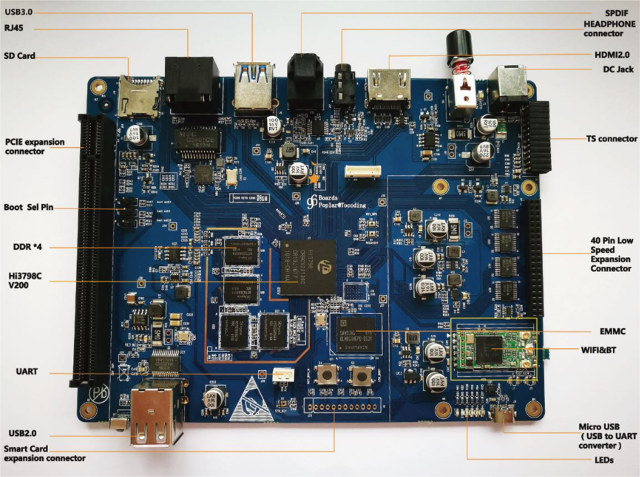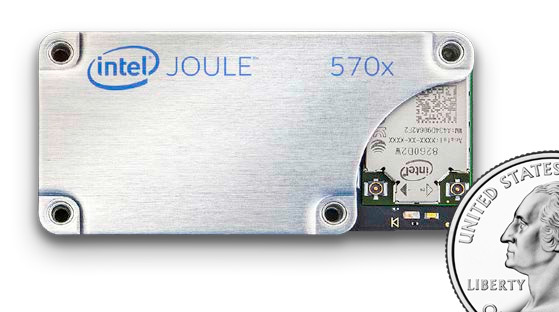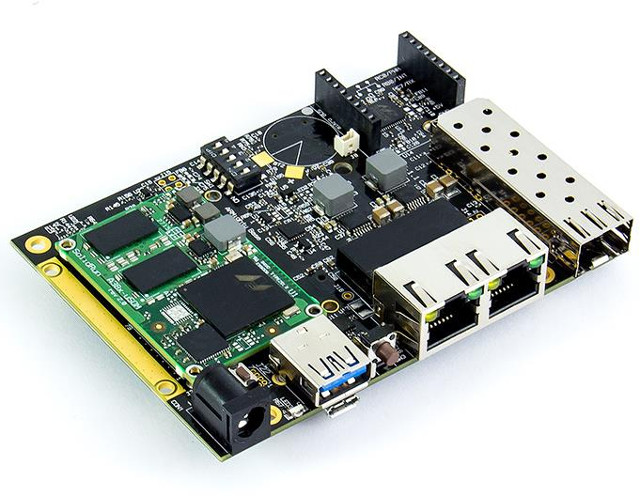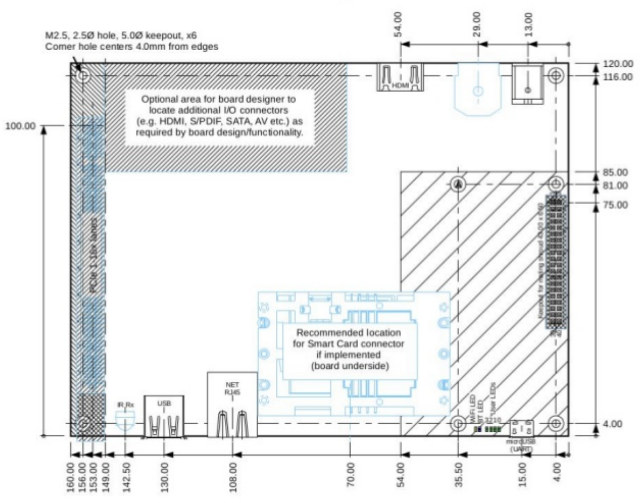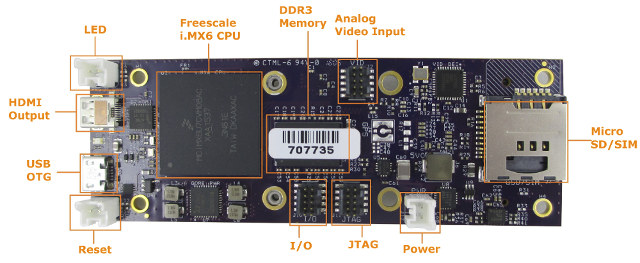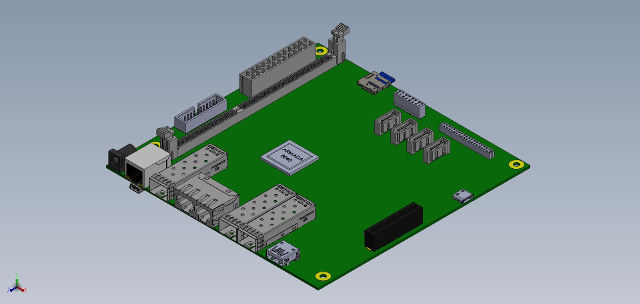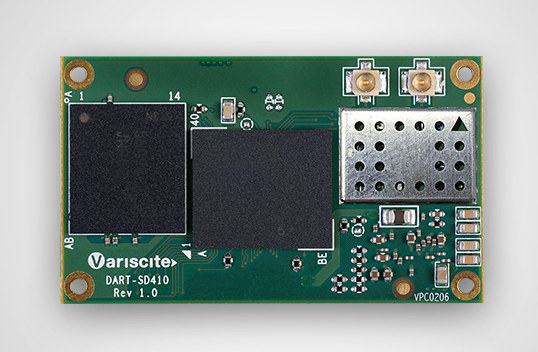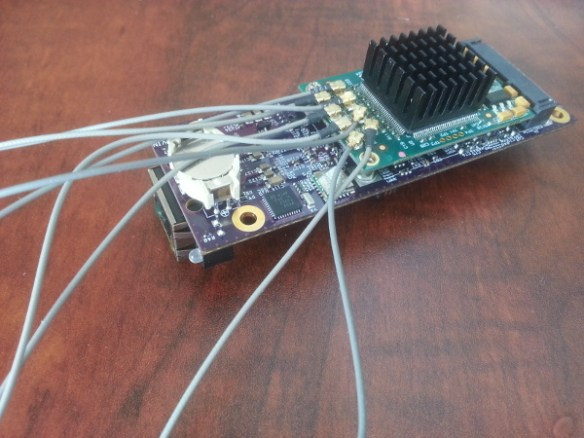At the end of last month I wrote about 96Boards TV Platform specifications, and noticed Hisilicon had one such boards, but details were sparse. Linaro has now officially unveiled HiSilicon Poplar board, the first 96Boards TV Platform board, sold for $79 + shipping on Aliexpress. Poplar board specifications: SoC – HiSilicon Hi3798C V200 quad-core 64-bit ARM Cortex-A53 CPU up to 2.0 GHz per core with ARM Mali-T720 GPU supporting OpenGL ES 3.1/3.0/2.0/1.1/1.0, OpenVG 1.1, OpenCL 1.2/1.1 Full Profile, RenderScript, and Microsoft DirectX 11 FL9_3 Memory – 1 or 2 GB DDR3 (Specs are conflicting depending where you look) Storage – 8GB eMMC flash + micro SD card slot Video Output – HDMI 2.0a with HDCP 2.2 up to 4K @ 60Hz Video Decoding – H.265/HEVC Main/Main10 and VP9 up to 4K @ 60 fps Audio Output – HDMI, optical S/PDIF, 3.5mm audio jack Connectivity – Gigabit Ethernet, 802.11 b/g/n/ac WiFi […]
Intel Unveils Joule Compute Module and Devkit for IoT based on Atom T5500 & T5700 Processors
As the Intel Developer Forum 2016 is now taking place in San Francisco, Intel has unveiled the Joule Compute Module and development kit targeting IoT applications. The module is not for low cost and low power sensor nodes however, as it features a powerful quad core Atom processor running at 1.5+ GHz, so it more suited to IoT gateways, or other application requiring lots of processing power to handle sensor data. Two models of the Joule module have been introduced: Intel Joule 570x platform SoC – Intel Atom T5700 64-bit quad-core processor @ 1.7 GHz / 2.4 GHz (Burst frequency) with Intel HD Graphics with 4K video capture and display System Memory – 4GB LPDDR4 RAM Storage – 16GB eMMC memory Connectivity – 802.11ac Wi-Fi with MIMO and Bluetooth 4.1 Other interfaces – USB 3.0, MPI CSI and DSI interfaces, and multiple GPIO, I2C, UART interfaces Intel Joule 550x platform […]
SolidRun ClearFog Base is a $90 Router/Networking Board with USB 3.0, M.2, mSATA, and Gigabit Ethernet Support
SolidRun introduced ClearFog Pro and Base board based on Marvell Armada 380/388 processor at the end of last year, but at the time, only the higher-end ClearFog Pro board was available for $170 and up. Now the company has officially launched the cheaper ClearFog Base board based on the same processor, two Gigabit Ethernet RJ45 ports, one SFP cage, a USB 3.0 port, an M.2 slot, mPCIe expansion slot, and more. ClearFog Base board specifications: Processor – Marvell ARMADA 388 (88F6828) dual core ARMv7 processor (Cortex A9 class) @ up to 1.6 GHz with 1MB L2 cache, NEON and FPU System Memory – 1GB RAM by default (2GB optional) Storage – 1x micro SD slot, optional 4GB eMMC flash, 1x M.2 slot, 1x mSATA/mPCIE Connectivity – 2x dedicated Gigabit Ethernet ports, 1x SFP cage USB – 1x USB 3.0 port Expansions 1x mini PCI Express slots (shared with mSATA ) 1x […]
96Boards Gets a TV Platform Edition Targeting $50 Mid-range Boards, $99 High-end Boards
96Boards was born as a hardware and software standard with Consumer (CE) & Enterprise Editions (EE), with different form factors with the latter focusing on server boards, but with similar software requirements requiring recent and mostly open source software. The consumer edition was also split into “Standard” and “Extended” editions, which the latter allowing for larger boards with more features, while the Enterprise Edition has its own larger format, as well as an option for micro-ATX form factor. I’ve just learned that a “fifth” 96Boards standard has been worked on with 96Board TV Platform for Home Gateways, OTT Streaming boxes, and TV boards with prices target of $50 or lower for mid-range boards, and $99 or lower for high-end boards. 96Boards TV Platform hardware requirements: Dimensions – 160 x 120 mm (EE Standard form factor) RAM – 1GB minimum; 2GB recommended Flash – 8GB eMMC minimum WiFi – 802.11 g/n […]
Gateworks Ventana GW5530 SBC is Designed for Drones, Robots, and Digital Signage
Gateworks Ventana is a family of boards based on NXP i.MX6 processor designed for embedded applications, and often include one or more mini PCIe ports for expansion. Their latest single board computer – Ventana GW5530 – is powered by an NXP i.MX 6Dual processor coupled with 512MB RAM, 256MB storage, a mini PCIe port, a micro SD / SIM card slot, micro HDMI output, and some I/Os. Ventana GW5530 specifications: SoC – NXP i.MX6 Dual Core ARM Cortex-A9 processor @ 800MHz with Vivante 2D and 3D GPUs System Memory – 512MB DDR3 (Up to 2GB as option) Storage – 256MB flash (Up to 2GB as option), micro SD/SIM card slot, serial configuration EEPROM Video & Audio Output – micro HDMI 1.4 port Connectivity – Optional u-blox EVA-M8M GPS Receiver with MMCX or u.FL Antenna Connector USB – 1x micro USB 2.0 OTG Port Sensors – 9-axis inertial module (accelerometer/gyro/magnetometer) Expansion […]
ARMADA 8040 Networking Community Board with a Quad Core ARM Cortex A72 SoC Coming Soon for $300 and Up
Developers interested in ARMv8 server or networking boards are starting to have more and more affordable choices. After AMD Opteron A1100 series based LeMaker Cello board, and Softiron Overdrive 1000 server, SolidRun is now working on ARMADA 8040 networking community board powered by Marvell ARMA8040 quad core Cortex A72 network processor. ARMADA 8040 networking board (mrvl8040) preliminary specifications: SoC – ARMADA 8040 (88F8040) quad core Cortex A72 processor @ up to 2.0 GHz with MoChi architecture System Memory – 4GB DDR4 DIMM by default Storage – 4x SATA 3.0 port + micro SD slot Connectivity – 1x Gigabit RJ45 port, 1x SFP SGMII @ 2.5Gbps, dual 10Gbps copper with auto switchover to dual SFP+ Expansion – 1x PCIe-x4 3.0 slot, Linaro 96Boards expansion slot exposing GPIO, UART, I2C and SPI, Marvell TDM module header USB – 1x USB 3.0 port, 2x micro USB ports Debugging – Console port (UART) over […]
Variscite DART-SD410 Snapdragon 410 SoM Comes with WiFi 802.11 b/g/n, Bluetooth 4.1 & GPS
Qualcomm Snapdragon 410 is the 64-bit ARM processor used in DragonBoard 410c 96Boards platform, but it’s also found in several phones, some single board computers such as Inforce 6309, and we’ve also seen it in system-on-modules includes Graperain G8916 and Intrinsyc Open-Q 410. Variscite has developed their DART-SD410 system-on-module based on the processor with up to 2GB RAM, up to 16GB storage, and on-board 802.11b/g/n WiFi and Bluetooth 4.1. DART-SD410 module specifications: SoC – Qualcomm Snapdragon 410 quad core Cortex A53 processor @ 1.2GHz with Adreno 306 GPU @ 400 MHz System Memory – 1 to 2GB LPDDR3 @ 533 MHz Storage – 8 to 16 GB eMMC 4.5 flash Connectivity – WiFi 802.11 b/g/n + Bluetooth 4.1 LE (WCN3620), GPS (WGR7640), and two u.FL antenna connectors Audio – PM8916 PMIC/Audio codec I/Os available via 2x 90-pin board-to-board connectors: Display 4-lane DSI up to 720p60/1080p30, 24-bit On-carrier DSI to HDMI […]
AVC8000nano mini PCIe Frame Grabber Captures up to 8 D1 Videos
There are plenty of solutions to stream or capture multiple video streams from cameras, but example for security purpose, but usually the equipment is relatively large and heavy. Advanced Micro Peripherals AVC8000nano mini PCIe capture card miniaturizes all that thanks to its form factor, and its 8 u.FL connectors used to capture eight D1 videos at full frame rate. AVC8000nano features: Video Inputs 8x Live NTSC/PAL video inputs with 8x 10-bit ADC and anti-aliasing filters 8x D1 size capture at full frame rate Formats – NTSC-M, NTSC-Japan, NTSC (4.43), RS-170, PAL-B,G,N, PAL-D, PAL-H, PAL-I, PAL-M, PAL-CN, PAL-60 SECAM Adjustments – Contrast, saturation, hue (or chroma phase), and brightness. Software adjustable Sharpness, Gamma and noise suppression Video Capture Formats – RGB555, RGB565, YCbCr 4:2:2, YCbCr 4:1:1 Windows support with Drivers and DirectShow/DirectDraw Linux with drivers and Video4Linux Form factor – Full height mini PCI Express Temperature Range – Commercial: 0°C to […]


